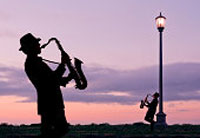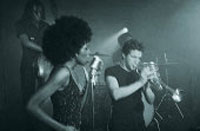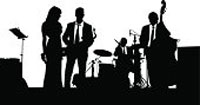
| HOME | MENU | DOCS | SEARCH |
Initially the jazz - dancing and musical culture of the lower class of the black population of America. As the musical direction I arose in the USA at a boundary of the XIX-XX centuries. Blacks are surprisingly musical. They sang, accompanying themselves cottons in palms, blows to empty boxes or on the self-made tool. As a result of transfer of Afro vocal music and a Black rhythm the new band music - the jazz was born in a tool form. The word "jazz" which appeared at the beginning of the XX century began to designate type of new music, and also the orchestra from wind, percussion and noise instruments executing this music. the 1920th became time of rough blossoming and universal distribution of the classical jazz.

Dancing style the jazz originates from ritual dances of the African people. From improvisation of the African rhythms and elements of jazz music the American jazz dance was born. The pioneer of jazz dance Jack Kol is considered. He processed and connected elements Indian, African, modern dance with rhythms of a swing and created the unique style. Its system allowed to develop jazz dance to modern level. The pupil Cola Matt Mattox connected this system to basic ballet equipment. Style blossoming the jazz fell on the 1960th together with blossoming of jazz music.
Improvisation (which follows from the nature of the African dance) and isolation are considered as bright features of jazz dance. Isolation (or polyrhythm, a politsentrika) means that the movements dancing as though come out various centers, different parts of a body move independently from each other, in different rhythms, is frequent with a different speed and different amplitude. Each part of a body can move not only separately, but also is opposite. Performers of jazz dance move softly; the impression is made that all movements begin from the weakened provisions. Dancing figures are under construction of a combination of difficult movements of hands and intricate movements of a body under an intensive rhythm of music.

To dance the jazz, it is necessary to be in a fine physical form and to possess special flexibility. Besides external equipment, the jazz demands from the performer of some traits of character, such as ease, relaxedness, cheerfulness, sense of humour.
Dance the jazz in its modern look, of course, strongly differs from its initial form. It changed, having incorporated elements of social dances hip-hop, a break dance, funk, etc., was divided into a set of types and schools and became very popular around the world. This type of dance is more widespread in connection with a modernist style (jazz modern), in such look it is present at many statements of modern ballet masters.
Is interesting that fact that the jazz equipment is used also by dancers of ballroom dances in the Latin American program. The jazz today - one of the best disciplines for complex development of a body. He allows to feel pair dance, maintaining, management, tricks, supports, rotations on one and in couple.
The jazz is very diverse. Distinguish the musical jazz - the facilitated direction allowing the dancer to sing and dance at the same time; ballet jazz, Broadway jazz.
The famous jazz dancers (for example, Matt Mattox in France, Gus Jordan and Luigi in the USA) who organized the schools of jazz dance often became ancestors of the new direction. They found certain approaches to training in dance, developed sets of movements and their combinations. There were terms of "technician Matt Mattox", "Luigi jazz", etc.

The jazz united elements of classical dance (see. Classical dance) (in the jazz there are both reversible and parallel positions of feet), the movements and receptions of a modernist style and national dance (see. National dance). Ethno - the jazz returns to sources of the African and Latin American dances.
The Afro-jazz - attempt to connect the jazz today's to his African ancestor. But the African dance bears in itself big semantic (shaman) loading and isn't so masterly, as its modern interpretation - the Afro-jazz. In it there are a lot of various "shakings" and small work of brushes and body. It is very effective in a combination to the street jazz. Many leading ballet masters use this mix for statements of choreography in clips of stars of MTV.
The street jazz - the "street" jazz, more other types kept the jazz in it in an original form. Free style without precisely verified lines and the tense socks, is a lot of acrobatic exercises on a floor.
All modern youth directions: the break dance, a house and a twist which were earlier, a Charleston, шейк, a boogie-woogie, etc. are kinds of the jazz and jazz connections with historical and household dance (see. Historical dance). Here it is important to be able to give the household movements tantsevalno. Though anything doesn't stand still, there is a continuous enrichment by new dancing receptions and mixture with other styles.
Photo from www.depositphotos.com
The recommended literature on dances
Maria Vasilevskaya "Dances from And to I" the Book about dances for laymen
We recommend that you look at the popular sections of the site myvaleology.com: MENU with a description of the sections | |||
| SOCIAL | DONATION | MY DIET | MY SPORT |

|
Release all4e8 |
||
Copyright © VZOJ 2023. All rights reserved. When reprinting or quoting myvaleology.com materials please put a link to the site myvaleology.com :
<a href="https://myvaleology.com">Healthy lifestyle</a>